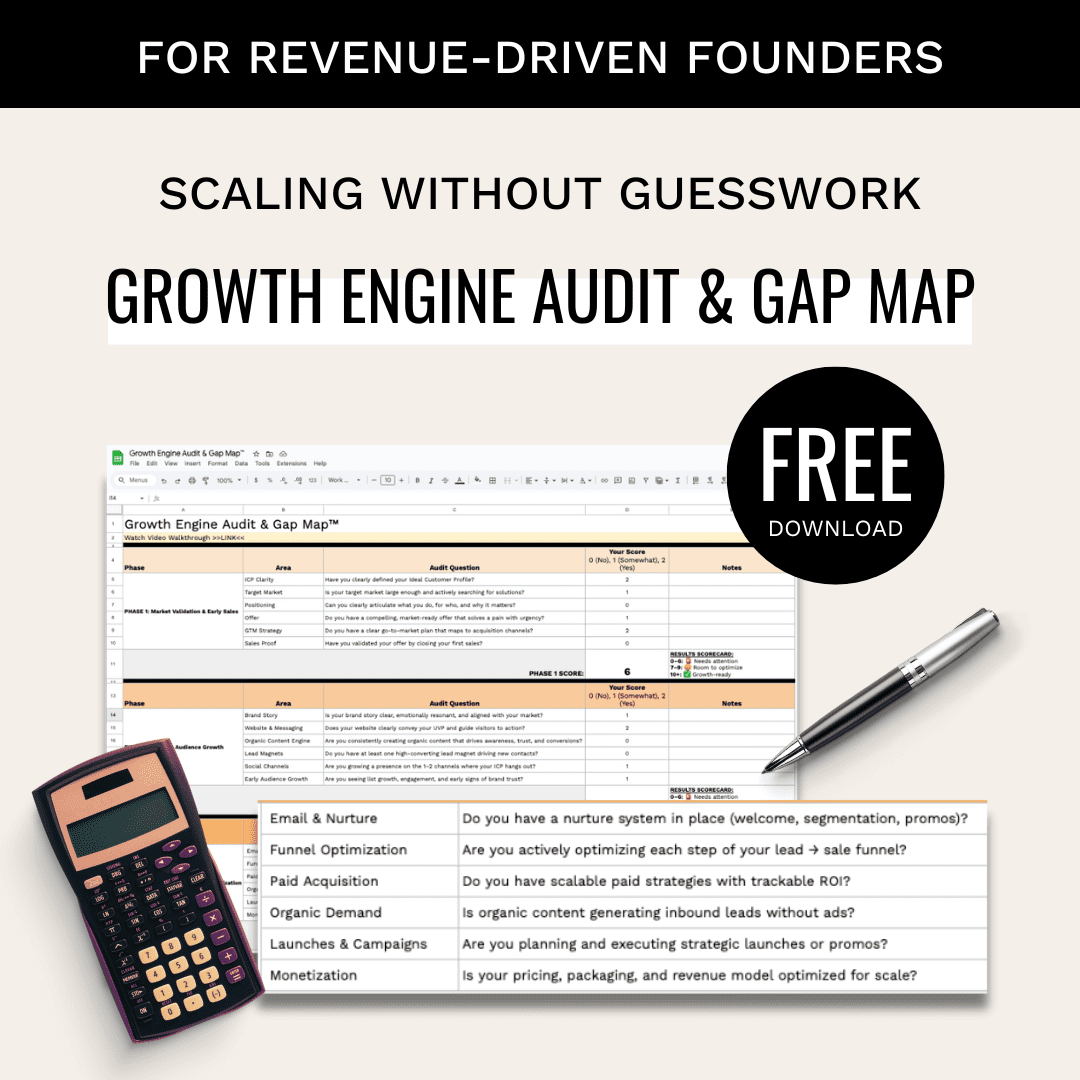- Canva: Create professional designs with over 2 million free templates and 4.5 million stock photos. Ideal for social media graphics, presentations, and marketing materials.
- Mailchimp: Manage email campaigns with a free plan that includes up to 500 contacts and 1,000 emails per month. Great for newsletters and simple automations.
- Apollo.io: A sales intelligence platform offering 60 email credits monthly, LinkedIn integration, and CRM tools to streamline B2B outreach.
- Loops.so: Simplifies email marketing for SaaS startups with up to 1,000 contacts and 4,000 emails per month. Perfect for onboarding and lifecycle emails.
- Tally.so: A free form builder with unlimited forms and submissions. Use it for lead generation, surveys, and payment collection.
- Dub.co: Manage branded short links and track up to 1,000 clicks monthly with detailed analytics and custom domains.
- Mixpanel: Analyze user behavior with up to 20 million monthly events. Ideal for tracking conversions and optimizing product features.
- Senja.io: Collect and showcase customer testimonials with customizable widgets. Supports text and video testimonials.
- Ahrefs Free SEO Toolkit: Perform keyword research, check backlinks, and optimize your website for search engines.
- Google Analytics 4 (GA4): Track website and app performance with advanced cross-platform analytics and machine learning insights.
Quick Comparison
| Tool | Free Plan Limits | Best For |
|---|---|---|
| Canva | 5GB storage, limited premium assets | Graphic design for non-designers |
| Mailchimp | 500 contacts, 1,000 emails/month | Email campaigns and lead nurturing |
| Apollo.io | 60 emails/month, 2 sequences | B2B sales and outreach |
| Loops.so | 1,000 contacts, 4,000 emails/month | SaaS email marketing |
| Tally.so | Unlimited forms/submissions | Lead generation and surveys |
| Dub.co | 1,000 clicks, 25 links/month | Campaign tracking and branded links |
| Mixpanel | 20M events/month | User behavior and conversion analysis |
| Senja.io | 15 testimonial items | Social proof and customer testimonials |
| Ahrefs Toolkit | 100 backlinks, basic keyword data | SEO and competitor research |
| GA4 | 14-month data retention | Website and app analytics |
These tools offer powerful features for free, making them perfect for startups in their early stages. As your business grows, consider upgrading to paid plans to unlock advanced capabilities.
Top 13 Free Marketing Tools To Supercharge Your Traffic
1. Canva
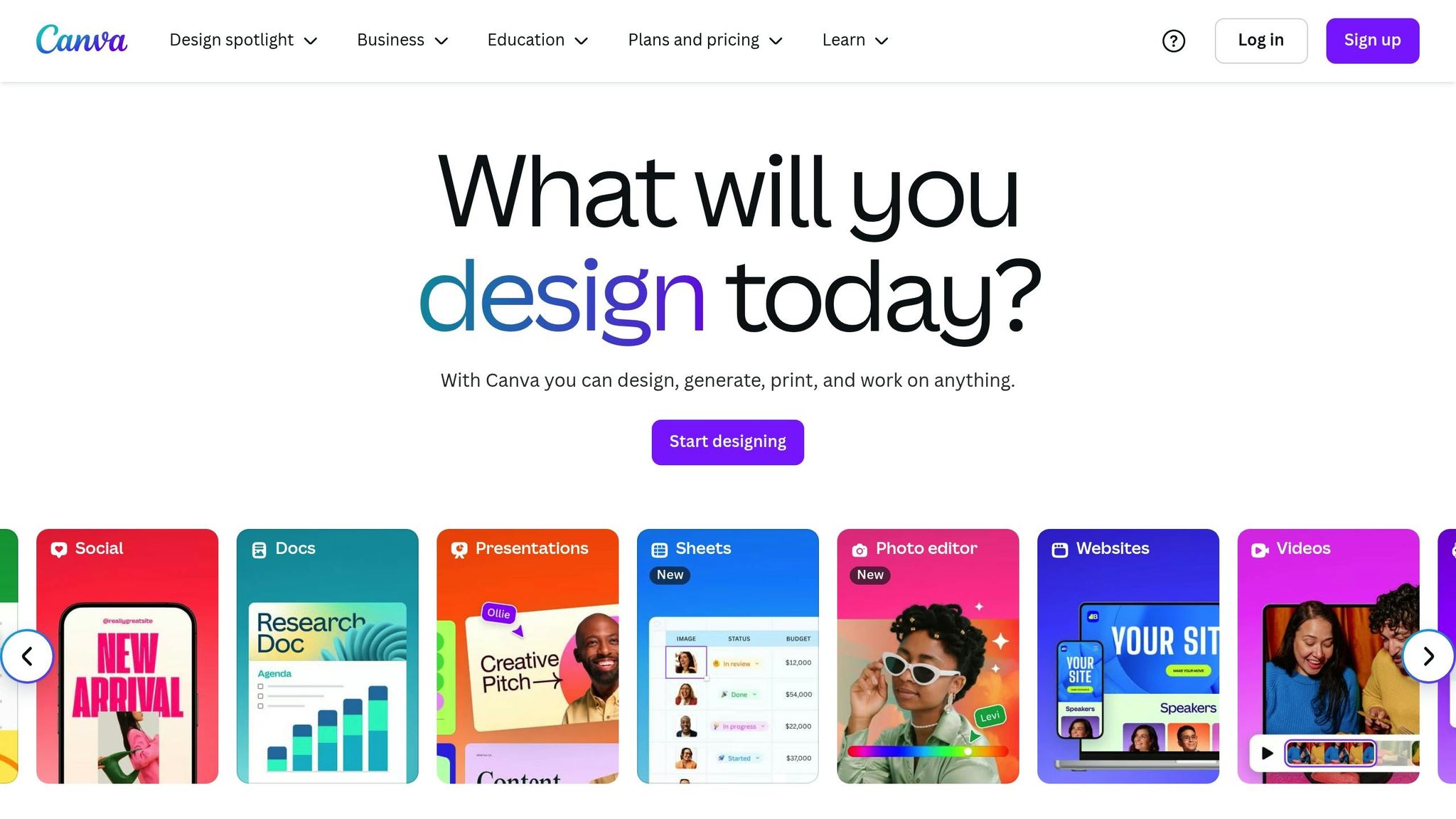
Canva provides professional-grade design tools for free, making it a go-to solution for startups that want polished marketing materials without stretching their budgets. This drag-and-drop platform has become indispensable for businesses that lack a dedicated design team or can’t afford pricey design software.
Key Features and Functionality
Canva’s free plan is packed with resources: over 2 million templates, more than 1,000 design types, and access to 4.5 million stock photos and graphics. It also includes integrated AI tools that speed up content creation by generating designs, images, and text in no time. The user-friendly drag-and-drop editor ensures that even non-designers can create professional work. You can craft interactive designs, combine multiple formats in one project, and even manage printing and delivery directly through Canva. Plus, the platform integrates seamlessly with over 120 apps – like HubSpot, Mailchimp, Google Drive, and Slack – streamlining the entire marketing process. All these features make it easy for startups to produce high-quality content at every stage of their marketing efforts.
Best Use Cases for Startups
Startups leverage Canva for a variety of needs, including pitch decks, product mockups, and marketing videos. It also simplifies ongoing tasks like creating social media strategy decks, competitor analyses, and brand guidelines. In fact, companies using Canva have reported a 60% increase in content creation and saved 230 design hours within just three months.
"To say Canva is a game-changer is a massive understatement. It has reinvented how we communicate and express our ideas. It’s a vehicle for robust storytelling, and it’s also transformed our ability to expedite projects on our end and do it very efficiently."
- Mark Davis, President and Creative Director, Hero Creative
Free Plan Limitations and Scope
The free plan includes 5GB of cloud storage, which is usually enough for early-stage startups. However, it does come with some restrictions. Access to premium templates and advanced AI features is limited, and tools like Magic Write and Magic Media have usage caps. The plan also offers just one brand kit, which may suffice for simple branding but could be restrictive as your business grows.
Scalability and Upgrade Triggers
Upgrading to Canva Pro ($120 annually) becomes worthwhile when your startup needs multiple brand kits, background removal tools, or expanded access to premium assets. The Pro plan is especially useful for translating designs, exporting in advanced formats, or using AI tools more frequently than the free tier allows. Many teams find that upgrading saves time and effort, especially when free plan limitations start to hinder productivity or when maintaining consistent branding becomes crucial for attracting and retaining customers. Investing in the Pro plan often pays off by boosting efficiency and cutting down on time spent navigating around constraints.
2. Mailchimp
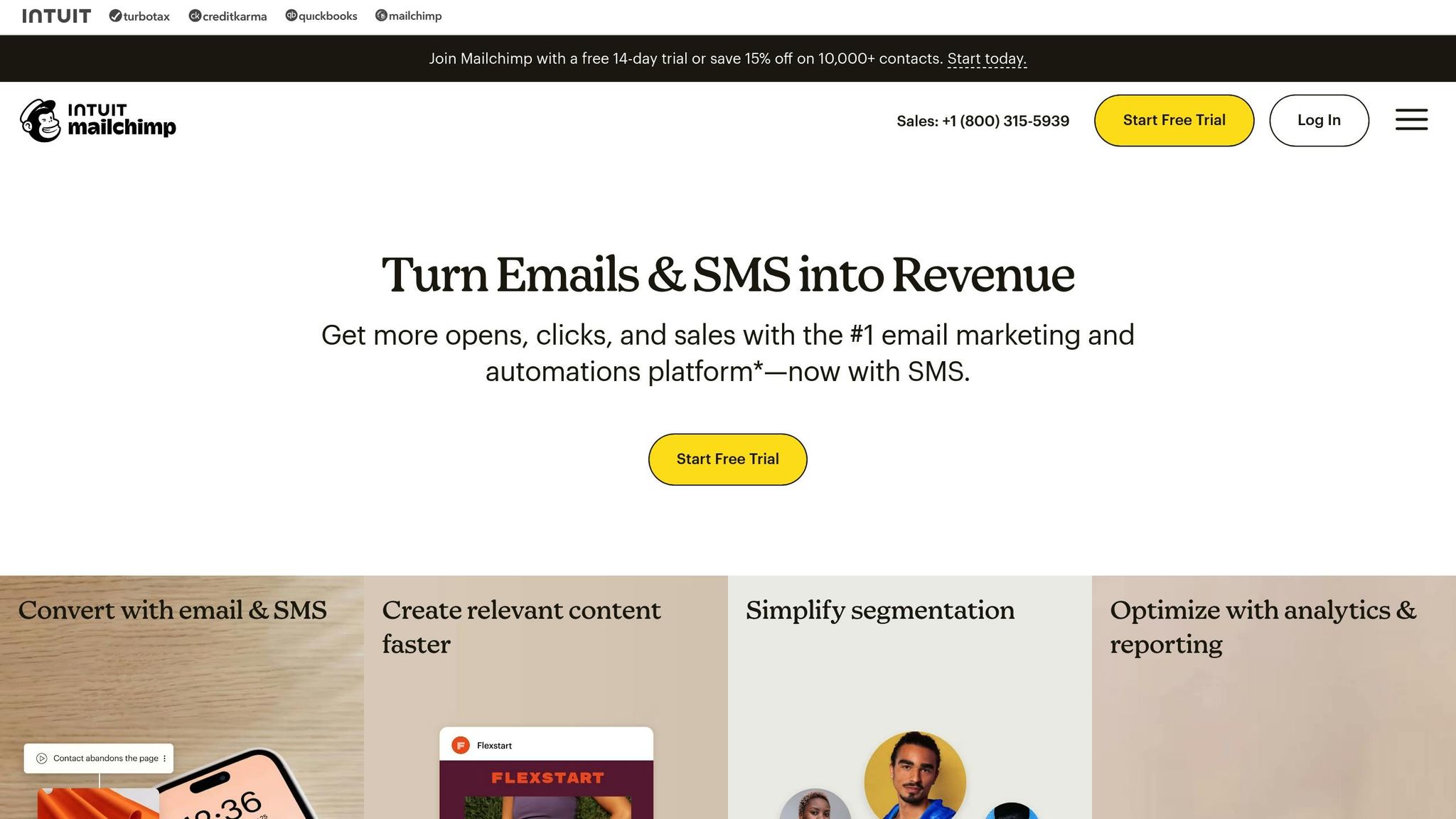
Mailchimp is a great starting point for startups dipping their toes into email marketing. With a user base exceeding 14 million, it’s a popular choice for businesses launching their first campaigns. Here’s a closer look at what Mailchimp offers, where it falls short, and when it might be time to upgrade.
Key Features and Functionality
Mailchimp’s free plan provides the basics you need to get started, including a simple CRM, reporting tools, a landing page builder, and pop-up forms. You’ll also find helpful features like segmentation, analytics, and unlimited lead capture forms. The drag-and-drop editor makes creating email campaigns a breeze, even if you’re not particularly tech-savvy. Plus, its integrations allow you to sync Mailchimp with other tools in your startup’s tech stack. The platform is designed to be user-friendly, so you can hit the ground running without a steep learning curve.
Free Plan Limitations and Scope
While Mailchimp’s free plan is a solid entry point, it does come with some restrictions. You’re limited to 500 contacts, 1,000 emails per month, and no more than 500 emails per day. You can only manage one audience or email list, and advanced features like campaign scheduling and multi-step automated sequences aren’t included. Emails sent on the free plan will carry Mailchimp branding, and customer support is only available during the first 30 days. Additionally, automation options are limited to basic, one-step sequences.
Best Use Cases for Startups
Mailchimp’s free plan is well-suited for startups that need an affordable way to collect emails and run simple campaigns. It’s ideal for sending newsletters, announcing new products, or running basic promotions for a small, engaged audience. Since you’re limited to one email list, focus on keeping it well-organized and use segmentation to tailor messages to different groups. The landing page builder can help you capture leads from other marketing efforts, and regularly cleaning up inactive or unsubscribed contacts will help you stay within the 500-contact limit.
Scalability and Upgrade Triggers
As your startup grows, you might find yourself needing more than the free plan can offer. If you surpass 500 contacts, send more than 1,000 emails a month, or require advanced automation, it’s time to consider upgrading. The Essentials plan, starting at $13/month for 500 contacts, introduces features like email scheduling, basic automation, and removes Mailchimp branding. For businesses looking to step up their game with advanced segmentation, A/B testing, and more sophisticated automation, the Standard plan starts at $20/month for 500 contacts. These upgrades can help you unlock more tools to drive better results as your email marketing needs evolve.
3. Apollo.io
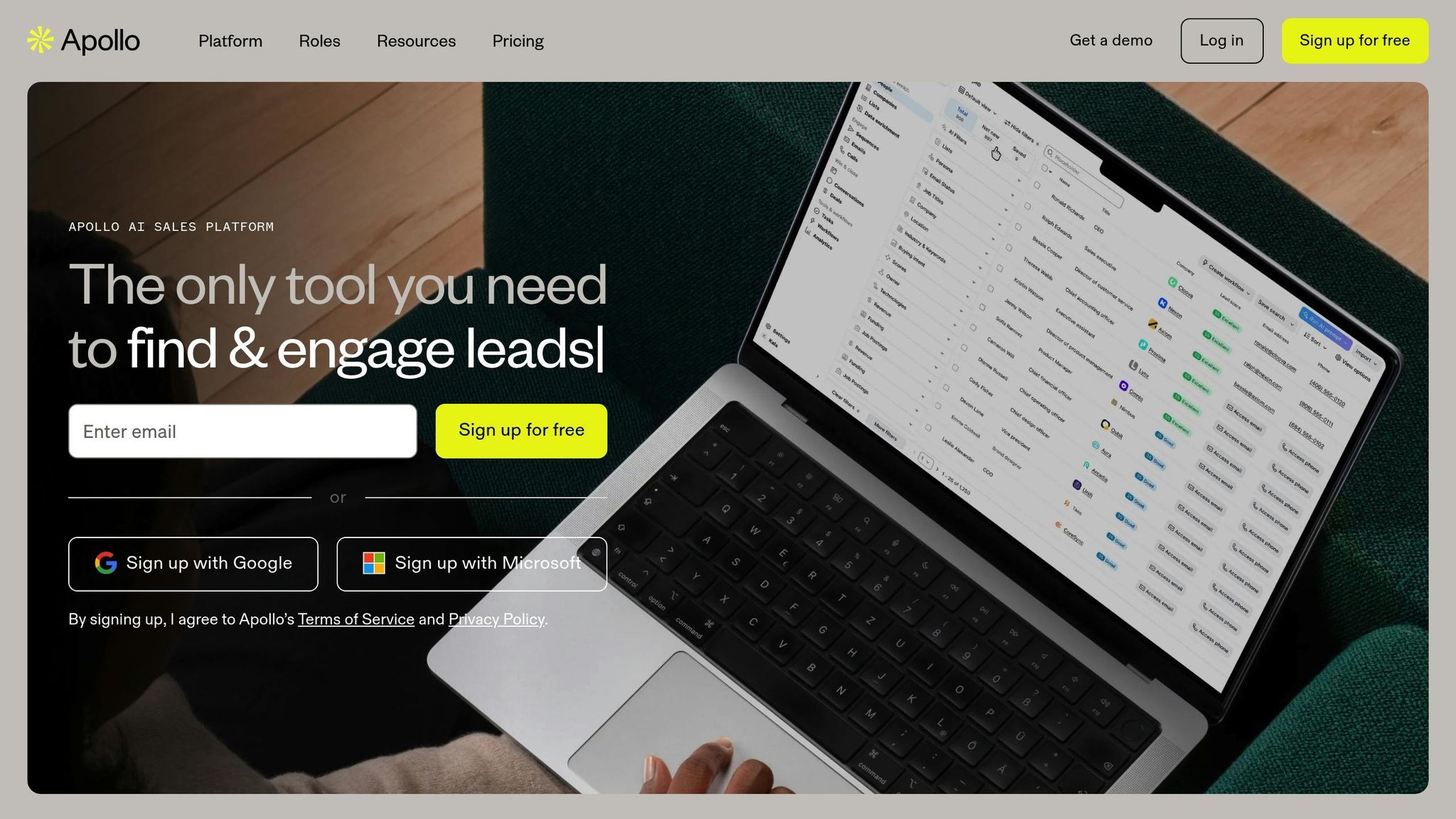
Apollo.io is a sales intelligence platform designed to help startups streamline their outreach and connect with prospects effectively. With over 500,000 companies relying on Apollo to stay ahead, it’s become a trusted tool for data-driven sales teams aiming to scale their efforts.
Key Features and Functionality
Apollo.io integrates prospecting, outreach, and CRM tools into one platform. It offers real-time sales insights, lead scoring, email sequencing, and call recording with analysis capabilities. The contact management system connects seamlessly with LinkedIn and Gmail, making it easy to verify and import prospect information.
The platform automates repetitive tasks like updating contact lists, scheduling follow-ups, and adapting email sequences when prospects change roles. Its AI-powered tools can even research prospects and craft personalized email content, drastically cutting down on manual work.
"You can find, for example, a high-intent head of talent that started their job within the last 6 months." – John Kim, Founder at Paraform
The CRM feature helps startups manage client relationships, monitor sales pipelines, and generate reports for smarter decision-making.
Free Plan Limitations and Scope
Apollo.io’s free plan is tailored for startups just starting their outreach journey. It includes 60 monthly email credits, two sequences, three intent topics, and a LinkedIn extension for retrieving contact details. Users can send up to 250 emails daily via the Gmail extension. These features make it a practical choice for startups building their initial sales pipeline.
Best Use Cases for Startups
Apollo.io is particularly effective for startups creating their sales pipelines from scratch. It’s a valuable tool for B2B companies aiming to identify decision-makers in their target industries. The platform simplifies prospect research, provides accurate contact details, and automates outreach sequences.
To get the most out of the free plan, startups should focus on their ideal customer profile (ICP). Use the LinkedIn extension to collect contact information while browsing profiles, then set up automated email sequences to nurture leads. Adding a multichannel approach, such as one extra touchpoint beyond automated emails, can boost meeting booking rates by up to 14%.
Scalability and Upgrade Triggers
As your startup grows, you may find the free plan’s limits restrictive. Upgrading becomes essential when you need more email credits, advanced search filters, or enhanced CRM integration. For example, Kinsta achieved a 36% connection rate using Apollo’s paid features, while Cyera increased their average booked meetings by 75% after upgrading.
Apollo’s Basic Plan starts at $49 per user per month, providing unlimited email credits, API access, higher contact limits, and mobile credits. For startups ramping up their outreach, these features enable sustained growth and improved efficiency.
"The automation we have in place allows our sales team to do what they do best – hop on calls to uncover pains and drive value in order to help our clients be more successful." – Paula Urrutia, Senior Sales Manager at Apollo
4. Loops.so
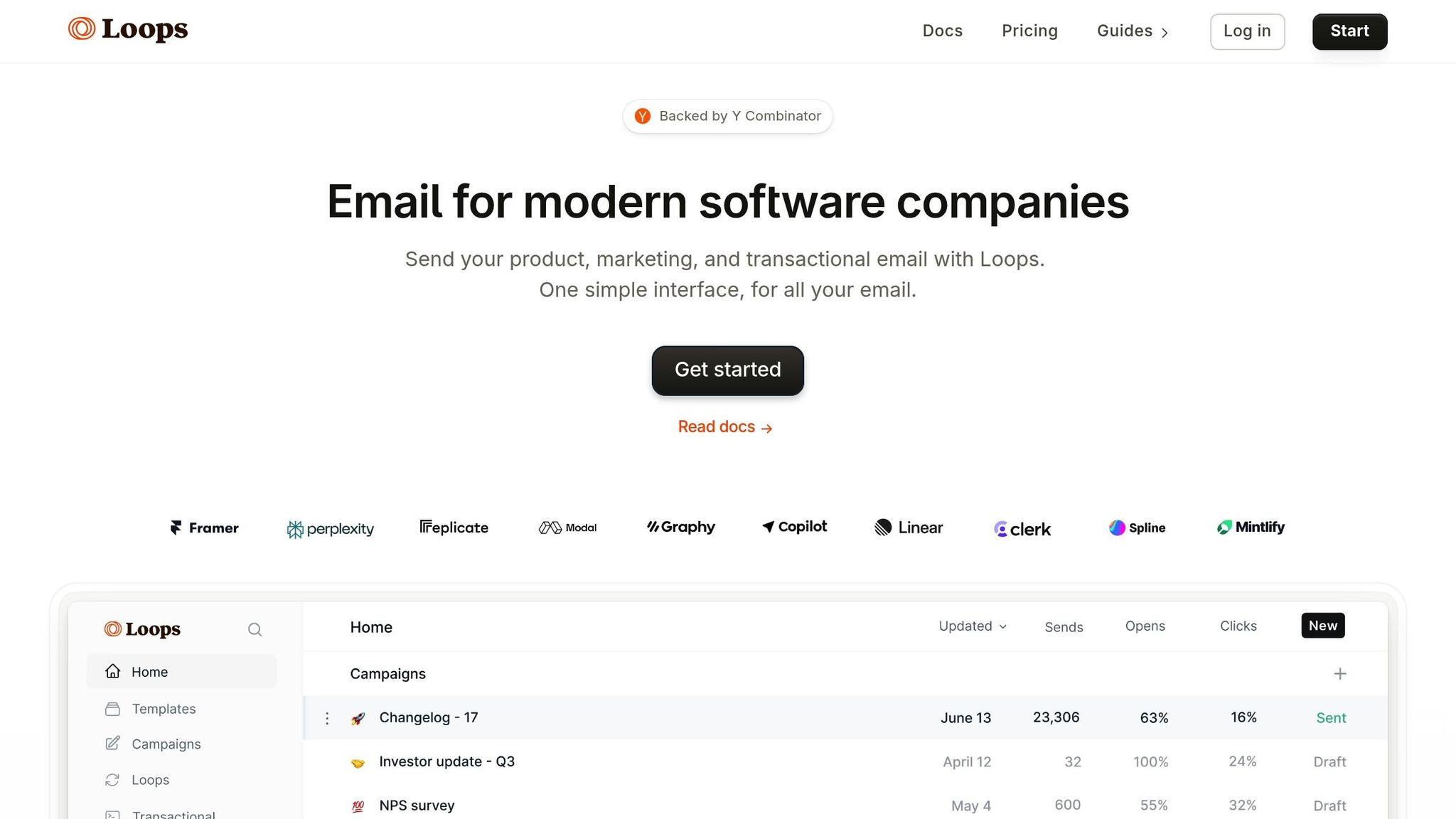
Loops.so is a streamlined email marketing platform built for SaaS teams that need speed without unnecessary complexity. By combining marketing and transactional emails into one tool, it simplifies communication and helps teams get their email campaigns up and running quickly. Here’s a closer look at what makes it stand out.
Key Features and Functionality
Loops.so is designed with developers in mind, offering an API that makes integration straightforward. This sets it apart from many general email marketing tools. The platform also features a block-based, drag-and-drop email editor, making it easy to create emails quickly. For SaaS teams, its segmentation tools are particularly useful, allowing you to target users based on specific actions like signups or upgrades.
Automation is another major strength. You can set up workflows that trigger email sequences based on user behavior or specific time intervals. Built-in A/B testing and detailed analytics let you fine-tune your campaigns and track engagement effectively.
Free Plan Limitations and Scope
Loops.so offers a free plan aimed at startups, which includes up to 1,000 contacts and allows for 4,000 email sends per month. This plan provides access to both marketing and transactional email tools, with the only limitation being a subtle "Powered by Loops" footer on outgoing emails. If your contact list grows beyond 1,000, you’ll need to move to a paid plan to continue using the platform.
Best Use Cases for Startups
This platform is particularly helpful for SaaS founders who want to get email campaigns up and running without hassle. It’s perfect for onboarding new users and setting up behavior-triggered lifecycle emails. David Ch, Head of Marketing at Encharge, shares his thoughts:
"Loops is great if you’re a technical founder running a SaaS and just want to get emails out the door fast. The setup’s easy, the UI is clean, and it does what it says on the tin."
Scalability and Upgrade Triggers
Loops.so grows alongside your startup’s email marketing needs. Once your contact list exceeds 1,000, you’ll need to upgrade to a paid plan, starting at $49 per month. As your business scales, the pricing adjusts based on the size of your contact list. Early-stage startups can take full advantage of the free plan for onboarding and basic lifecycle emails. Over time, the developer-friendly API becomes even more valuable for creating advanced email flows tied to user activity, ensuring the platform remains useful as your needs evolve.
5. Tally.so
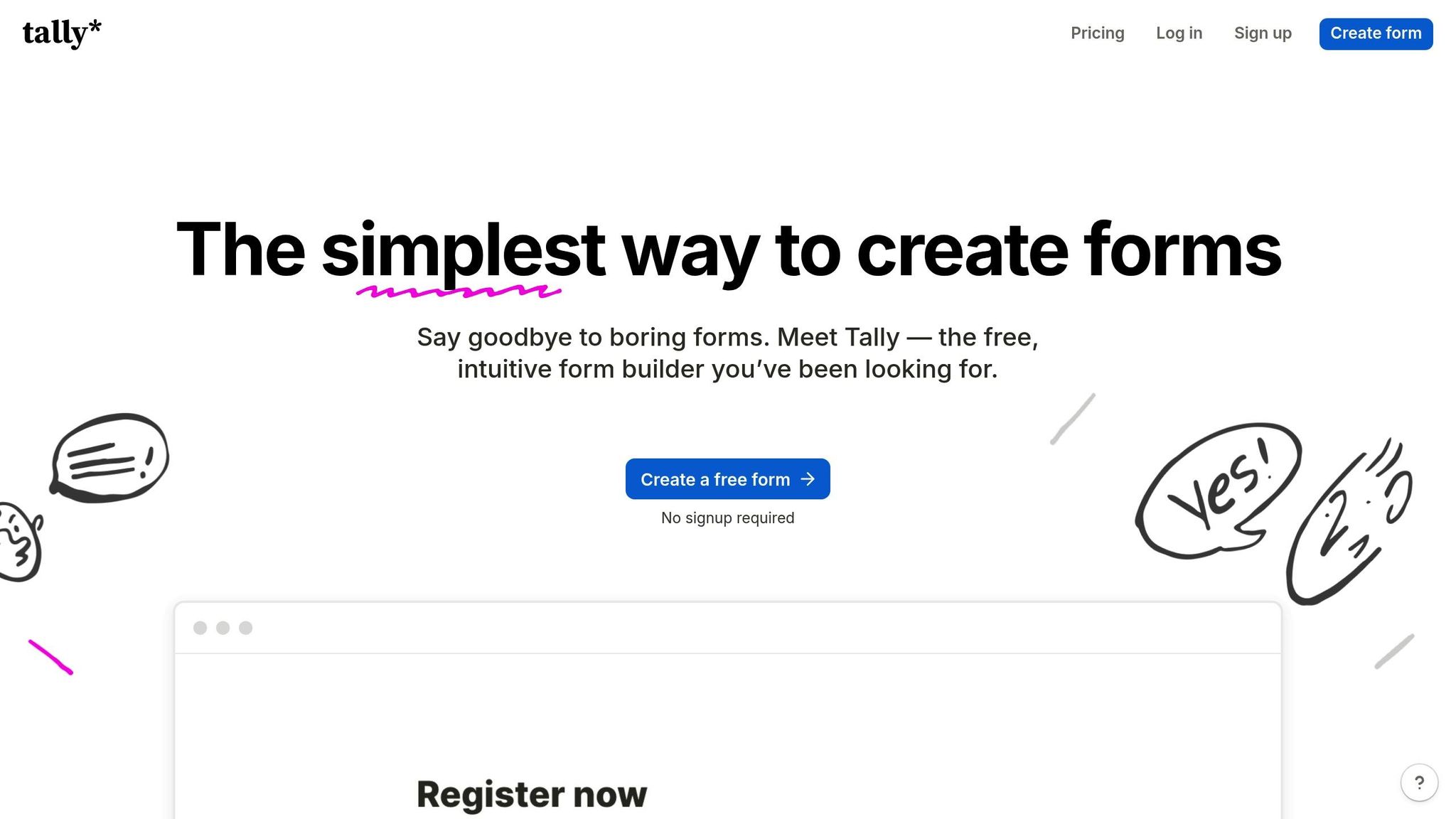
Tally.so is a free and user-friendly form builder with a Notion-inspired interface, making it easy for startups to create forms without hassle. Whether you need simple contact forms or detailed surveys, Tally.so provides a familiar and efficient platform, helping startups achieve their goals without overspending.
Key Features and Functionality
Tally.so packs a range of features typically found in paid form builders. It includes conditional logic to show or hide questions based on user responses, calculation tools for crafting quote forms or surveys with scoring, and answer piping to personalize follow-up questions using previous answers. You can also use hidden fields to track campaign sources or user data automatically.
Customization is another strong point. You can tweak themes, fonts, and colors or even add custom CSS for complete design flexibility. Need to collect payments? Tally integrates directly with Stripe, enabling you to create order forms, donation pages, or subscription sign-ups effortlessly. Additionally, Tally connects with tools like Notion, Airtable, Google Sheets, and Slack through native integrations and webhooks.
"Tally is doing to forms what Notion did to docs & sheets." – Natan Castiel, Head of Growth, Gelt
Free Plan Limitations and Scope
Tally.so’s free plan is generous, offering unlimited forms and submissions. However, it does have a few limitations: forms include Tally branding, file uploads are capped at 10MB, and there’s a 5% commission on payments processed through Stripe. Despite these restrictions, Tally’s free plan outshines competitors like Typeform, which limits free accounts to just 10 responses per month. According to research, 90% of startups using Tally Forms reported increased efficiency in collecting data and managing customer feedback.
Best Use Cases for Startups
Tally.so’s robust features make it ideal for a variety of startup needs. Use it to:
- Generate leads by embedding forms on your website or sharing links.
- Collect customer feedback to refine your product.
- Process job applications as your team expands.
- Accept payments for pre-orders or simple product sales.
"Absolutely adore Tally! A game-changer – incredibly powerful, yet ridiculously user-friendly. It enabled me to effortlessly gather inputs, add forms with ease, and even pre-fill them. And the icing on the cake – absolutely free to use!" – Shyam Verma, Digital creator
For internal purposes, Tally is perfect for employee surveys, event registrations, and gathering feedback from beta users.
Scalability and Upgrade Triggers
As your startup grows, you may find it beneficial to upgrade to Tally Pro, which costs $29/month (or $24/month annually). The Pro plan removes Tally branding, eliminates the 5% Stripe commission, and lifts the 10MB file upload limit. It also adds advanced features like Google Analytics 4 integration and the ability to capture incomplete form responses. Upgrading becomes essential when you need white-labeled forms or when Stripe’s commission starts cutting into your revenue. However, for most early-stage startups, the free plan offers everything you need to kickstart professional data collection and lead generation.
6. Dub.co
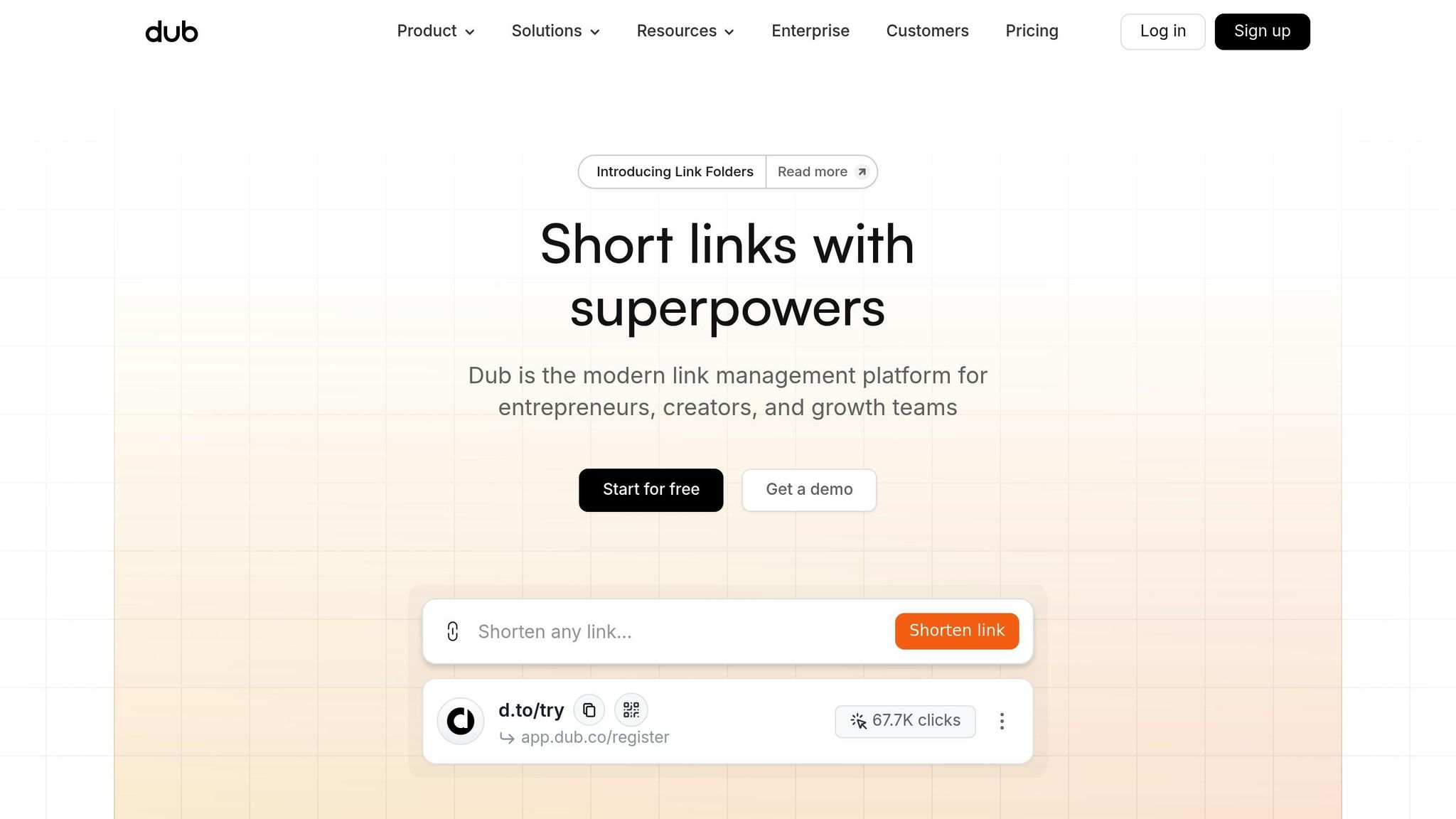
Dub.co is an open-source link management tool designed to help startups keep track of and improve their marketing campaigns. Unlike standard URL shorteners, Dub.co combines detailed analytics with branded link options, making it easier to understand your audience and drive conversions – all without spending a penny. Let’s dive into what makes this platform stand out.
Key Features and Functionality
Dub.co allows you to create branded short links that not only look professional but also build trust with your audience. Even on the free plan, you can use up to 3 custom domains for your links, and every shortened link comes with an automatically generated QR code, making it easier to connect offline and online campaigns.
Here’s what else Dub.co brings to the table:
- Branded short links and QR codes for seamless marketing.
- Analytics that track devices, locations, and referral sources.
- A built-in UTM builder to simplify campaign tracking.
- Device and geo-targeting to redirect users based on their location or device type.
For teams, Dub.co offers collaboration features, letting you invite members to manage links together. Plus, its API enables you to integrate the platform into your existing workflows, making it easier to scale and automate link creation.
"Dub is simply put the best way to track links and measure attribution. It’s easy, clean, and just works – while all the alternatives look bloated, complicated, and dated." – Jorn Van Dijk, CEO, Framer
Free Plan Limitations and Scope
Dub.co’s free plan is a great starting point, offering 25 new links per month and tracking up to 1,000 clicks. Analytics data is available for 30 days, and you can access features like an AI assistant, link tags, API support, UTM templates, and up to 3 custom domains.
To get the most out of the free plan, focus on creating links for your most impactful campaigns. Use UTM templates to track performance on your top channels, and review your analytics data regularly within the 30-day window to spot opportunities for improvement.
Best Use Cases for Startups
Dub.co is an invaluable tool for startups looking to fine-tune their marketing efforts. For social media campaigns, it provides insights into which platforms are driving the most engagement and conversions. With Stripe integration, you can even track the full customer journey from the initial click to the final purchase.
For content marketing, Dub.co helps identify which blog posts, videos, or other resources are pulling in the most traffic. Its A/B testing feature allows you to experiment with messaging and see what resonates best with your audience.
If you’re running affiliate programs, Dub Partners can simplify managing cost-per-click, cost-per-lead, and conversion campaigns. Dedicated dashboards make it easy to track performance and handle payouts.
"Dub has been a game-changer for our marketing campaigns – our links get hundreds of thousands of clicks monthly and with Dub, we are able to easily design our link embeds, attribute clicks, and visualize our data." – Johnny Ho, Co-founder, Perplexity
Scalability and Upgrade Triggers
Once your campaigns outgrow the free plan – whether you need more than 25 new links or exceed 1,000 tracked clicks per month – it might be time to upgrade. The Pro plan, priced at $19/month (billed annually), supports 50,000 tracked clicks and 1,000 new links each month, making it a good fit for startups with active social media or content strategies.
For businesses handling larger volumes, the Business plan at $49/month covers up to 150,000 tracked clicks monthly and includes advanced features like conversion tracking integrations for e-commerce platforms. For early-stage startups, however, the free plan offers plenty of functionality to get started. Upgrading becomes a natural step as your campaigns scale and your needs grow beyond the free tier.
sbb-itb-e8c8399
7. Mixpanel
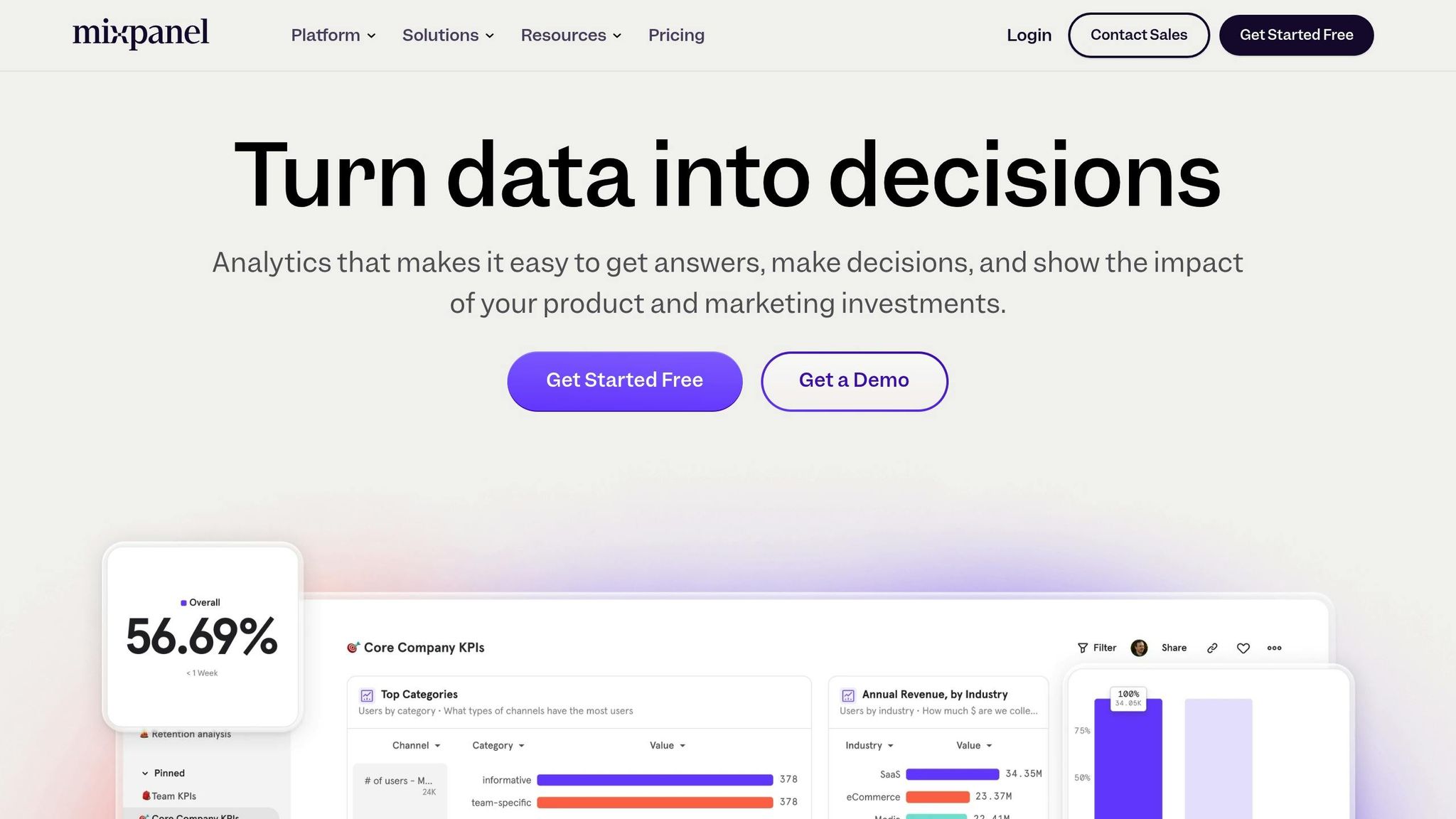
Mixpanel helps businesses make informed decisions by tracking how users interact with their products. Unlike traditional web analytics that focus on page views, Mixpanel digs deeper by monitoring specific user actions like button clicks, feature usage, and key conversion points. This approach allows companies to fine-tune their product experiences based on real user behavior.
Key Features and Functionality
For early-stage companies, Mixpanel’s free plan offers a solid starting point. It allows tracking up to 20 million monthly events, making it a great fit for startups in their growth phase. The free plan includes essential tools like Insights, Funnels, Retention, and Flows reports, along with live event tracking, custom dashboards, integrations, and on-the-fly data modeling. Additionally, you can create custom events to zero in on specific user actions for sharper insights.
What makes Mixpanel stand out is its intuitive interface, which makes advanced analytics accessible even to teams without technical expertise. You can build funnels to track conversion rates, examine retention patterns over time, and segment users based on their behavior – all displayed on real-time dashboards that update as users engage with your product. However, these features do come with limits in the free plan.
Free Plan Limitations and Scope
While the free tier is generous, there are some restrictions. The 20 million monthly event cap is a key limitation, and advanced features like anomaly detection or custom retention metrics are not included. Data retention and premium reporting options are also more limited compared to paid plans. To make the most of the free plan, focus on tracking the most critical user actions – like sign-ups, feature usage, and conversion milestones – and use the core reports (Insights, Funnels, Retention, and Flows) to analyze this data effectively.
For startups looking for more, Mixpanel’s Startup Program offers the first year free on their exclusive Startup Plan. This program also includes $50,000 in Growth and Enterprise credits, allowing you to track up to 1 billion annual events.
Best Use Cases for Startups
Mixpanel is a powerful tool for startups that want to understand user behavior and improve their product experience. It can help refine onboarding processes by pinpointing where users drop off, monitor how features are being adopted, and inform product roadmaps based on actual usage data. This makes it particularly valuable for SaaS companies, mobile apps, and e-commerce startups that need to track complex user journeys. To maximize its impact, focus on a handful of key metrics – typically 3–5 – that align with your product goals. Regularly review dashboards to identify trends, test hypotheses, and adjust strategies.
Scalability and Upgrade Triggers
The free plan is ideal for small SaaS companies and early-stage startups, but as your business grows, you may hit the 20 million monthly event cap or require advanced features like Group Analytics. At this point, upgrading becomes essential. Mixpanel’s Growth plan starts at around $24 per month. They also offer annual discounts and significant savings – ranging from 50% to 90% – for eligible nonprofits and startups. When your event volume or analytics needs surpass the free tier, investing in a paid plan can provide the advanced tools and capacity you need to keep scaling effectively.
8. Senja.io
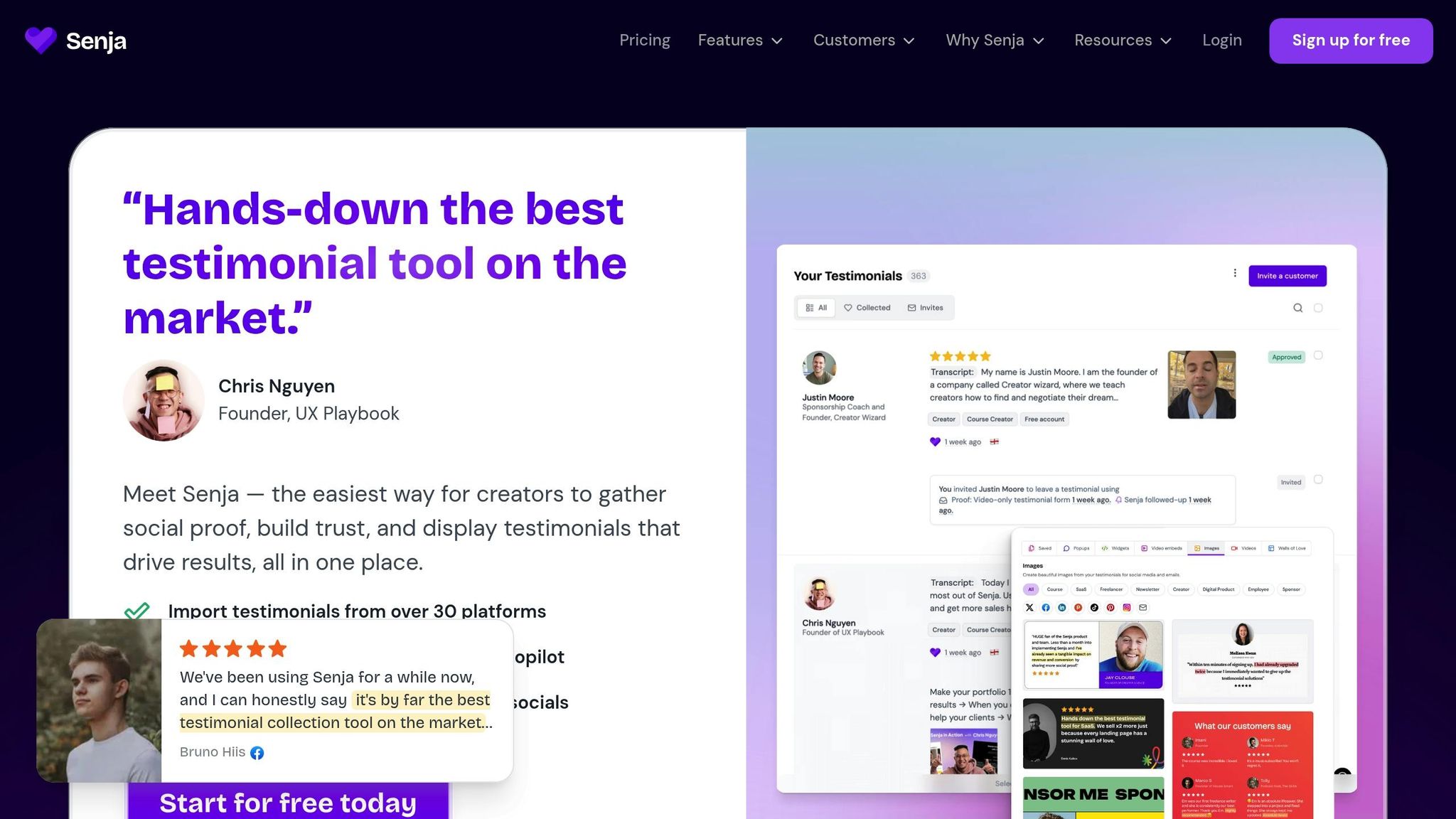
Senja.io transforms the way startups gather and showcase customer testimonials. It simplifies collecting text and video testimonials, then lets you display them through customizable widgets. Considering that 88% of people trust online testimonials as much as recommendations from friends, Senja helps build trust without requiring technical skills, making it a valuable tool for any lean startup’s marketing efforts.
Key Features and Functionality
Senja streamlines testimonial management with customizable forms and easy-to-share links. You can pull in testimonials from over 30 platforms – like Shopify, G2, and Yelp – or upload them using a CSV file, centralizing all your social proof in one place.
One standout feature is the platform’s auto-transcription for video testimonials, which saves time and effort. Its no-code widget builder allows you to create and display testimonials without needing a developer. You can even build "Walls of Love" to showcase testimonials anywhere on your website. Plus, Senja integrates smoothly with tools like Notion, Slack, and Zapier.
What makes Senja unique is its focus on automation and customer engagement. The platform can automatically request testimonials during key "success moments" and send thank-you messages, making it easier to maintain strong relationships with customers while growing your testimonial library.
Free Plan Limitations and Scope
Senja’s free plan offers a solid starting point, allowing you to display testimonials for up to 15 items. This limit applies to the number of products, services, or campaigns you can create testimonial collections for – not the total number of testimonials you can collect.
The free tier includes essential features like testimonial collection forms, basic widget creation, and importing testimonials. However, advanced customization, unlimited collections, and premium display options are only available in paid plans. For startups just beginning to experiment with social proof or those focusing on a single product, the free plan provides enough functionality to get started.
Best Use Cases for Startups
Senja is ideal for startups looking to quickly establish trust and boost conversions with social proof. Testimonials can increase conversions by 34–380%, making them invaluable for e-commerce, SaaS, and service-based businesses. Video testimonials, in particular, drive 157% more organic traffic, showcasing the importance of Senja’s video collection and transcription features for content marketing.
"Less than a month into implementing Senja and I’ve already seen a tangible impact on revenue and conversion by sharing more social proof."
– Jay Clouse, Founder of Creator Science
Startups should focus on collecting testimonials during pivotal customer moments – such as after onboarding, feature adoption, or positive support experiences. Senja’s automation tools make it easy to gather testimonials systematically. As your needs expand, upgrading to a paid plan will unlock additional features.
Scalability and Upgrade Triggers
While the free plan works well for startups with a single product or service, scaling up might require an upgrade. Senja’s Pro plan, priced at $16.00 per month (monthly billing) or $19.00 per month (annual billing), offers unlimited testimonials, advanced customization, and the ability to create unlimited "Walls of Love."
You might consider upgrading when managing multiple products, needing more branding options, or wanting to remove Senja branding from your displays. For larger needs, the Business plan starts at $49.00 per month (monthly billing) or $59.00 per month (annual billing), offering enterprise-level features. Agencies managing multiple client accounts can opt for the Agency plan at $399.00 per month. Investing in a paid plan becomes worthwhile when your testimonials are driving measurable improvements in conversions and when advanced management tools are needed.
"Senja made it so easy and quick to collect testimonials. Took me less than 5 minutes to start collecting them, and adding them to my website was even quicker! Thanks for this awesome tool."
– Jamie Northrup, Minimalist Hustler
9. Ahrefs Free SEO Toolkit
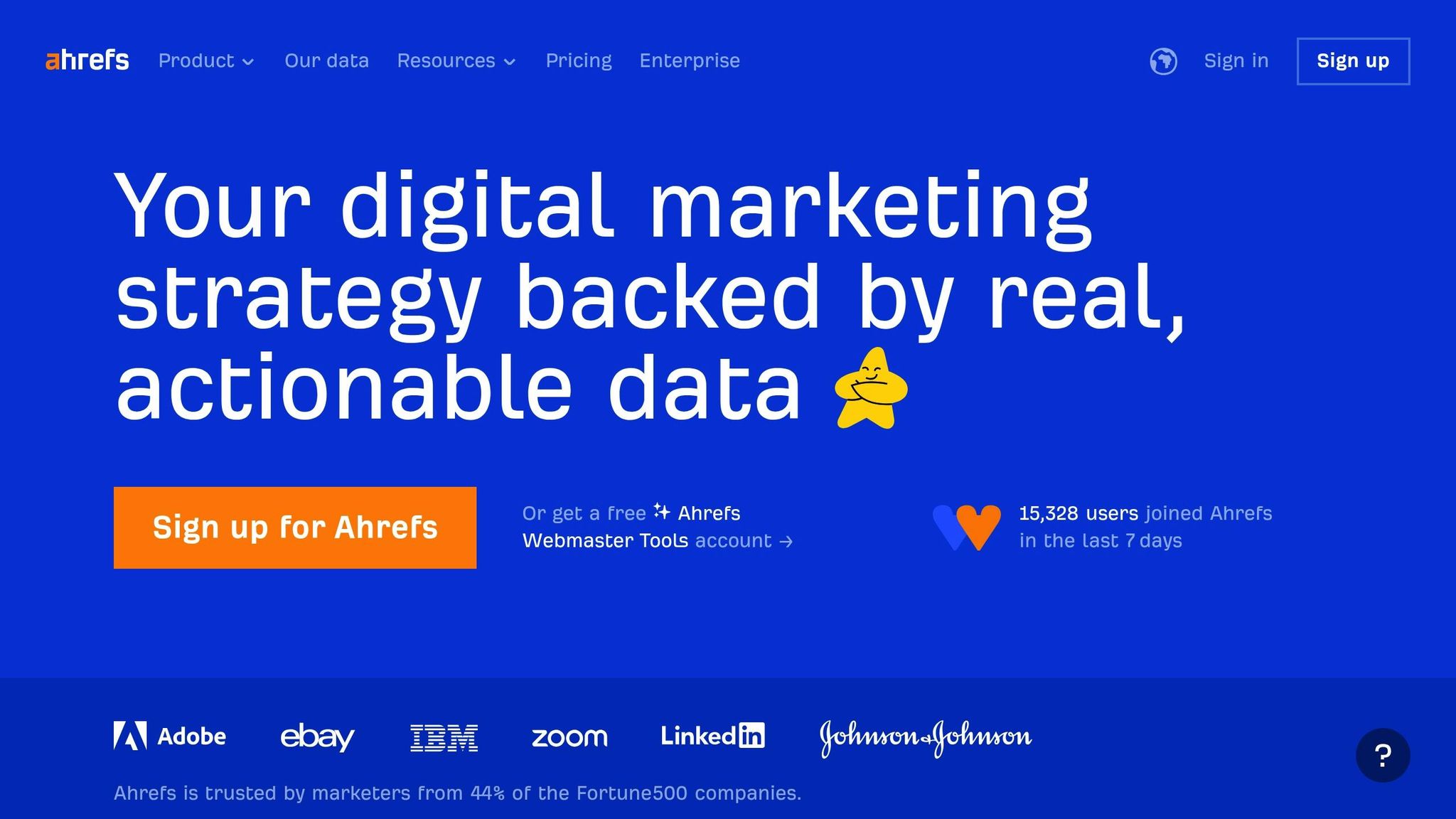
Ahrefs Free SEO Toolkit provides startups with access to powerful SEO tools at no cost. With a database of over 20.8 billion indexed keywords and the second-largest web crawler after Google, this toolkit empowers startups to improve their search rankings. It includes tools like keyword generators, backlink checkers, and Ahrefs Webmaster Tools (AWT), all designed to strengthen your organic search strategy. This free offering is a great addition to your marketing arsenal, addressing key SEO needs. Let’s break down how its features can support your SEO efforts.
Key Features and Functionality
The free toolkit covers essential SEO tasks. The keyword generator works across major platforms, offering data on search volume and keyword difficulty. The backlink checker provides a snapshot of up to 100 backlinks per website, helping you analyze competitors and assess link-building opportunities.
Ahrefs Webmaster Tools (AWT) is another standout feature, scanning your verified website for technical SEO issues while showcasing your ranking keywords and backlink profile.
"Ahrefs Webmaster Tools (AWT) scans your site for 100 common SEO issues affecting rankings. It also tells you what keywords you’re ranking for, who’s linking to you and from where." – Si Quan Ong, Content Marketer @ Ahrefs
Additionally, a browser extension offers on-page SEO analysis, and a free WordPress plugin supports content audits.
Free Plan Limitations and Scope
While the free tools are valuable, they come with limitations. AWT works only for websites you own and verify, so you can’t perform in-depth competitor analysis. The backlink checker is restricted to showing 100 links per domain, offering a limited view compared to the comprehensive data in paid plans. Similarly, the keyword tools provide basic metrics like search volume and difficulty but lack advanced features such as click-through rates or keyword trends. Historical data and bulk analysis are also unavailable in the free plan.
"This selection of free SEO tools will help you with various SEO tasks, such as keyword research, on-page SEO, link building, and more… While limited compared to a paid Ahrefs account, they’re still immensely valuable for anyone who’s just starting out in SEO." – Ahrefs
Despite these constraints, the free toolkit is a strong starting point for startups focusing on website optimization and basic competitor research.
Best Use Cases for Startups
Ahrefs’ free tools are perfect for building a solid SEO foundation. Use the keyword generator to find content ideas that align with your audience’s search patterns. The backlink checker is ideal for analyzing competitor link-building strategies and discovering opportunities for your own site.
AWT is particularly helpful for maintaining your site’s health. It can identify issues like pages with a noindex tag that block Google from indexing your content. You’ll also receive regular email updates about your site’s SEO status, making it easier to address problems quickly. For content planning, AWT insights can highlight which pages drive the most organic traffic and which keywords are already performing well. These insights can guide your optimization efforts and enhance your overall marketing approach.
Scalability and Upgrade Triggers
The free toolkit is best suited for startups managing a single website and focusing on basic SEO tasks like content optimization and technical fixes. As your needs grow – such as requiring more detailed competitor insights or managing multiple websites – it may be time to consider upgrading to a paid plan. Until then, focus on fine-tuning your site’s technical SEO, optimizing content around your existing keyword rankings, and conducting targeted competitor research to get the most out of these free tools.
10. Google Analytics 4
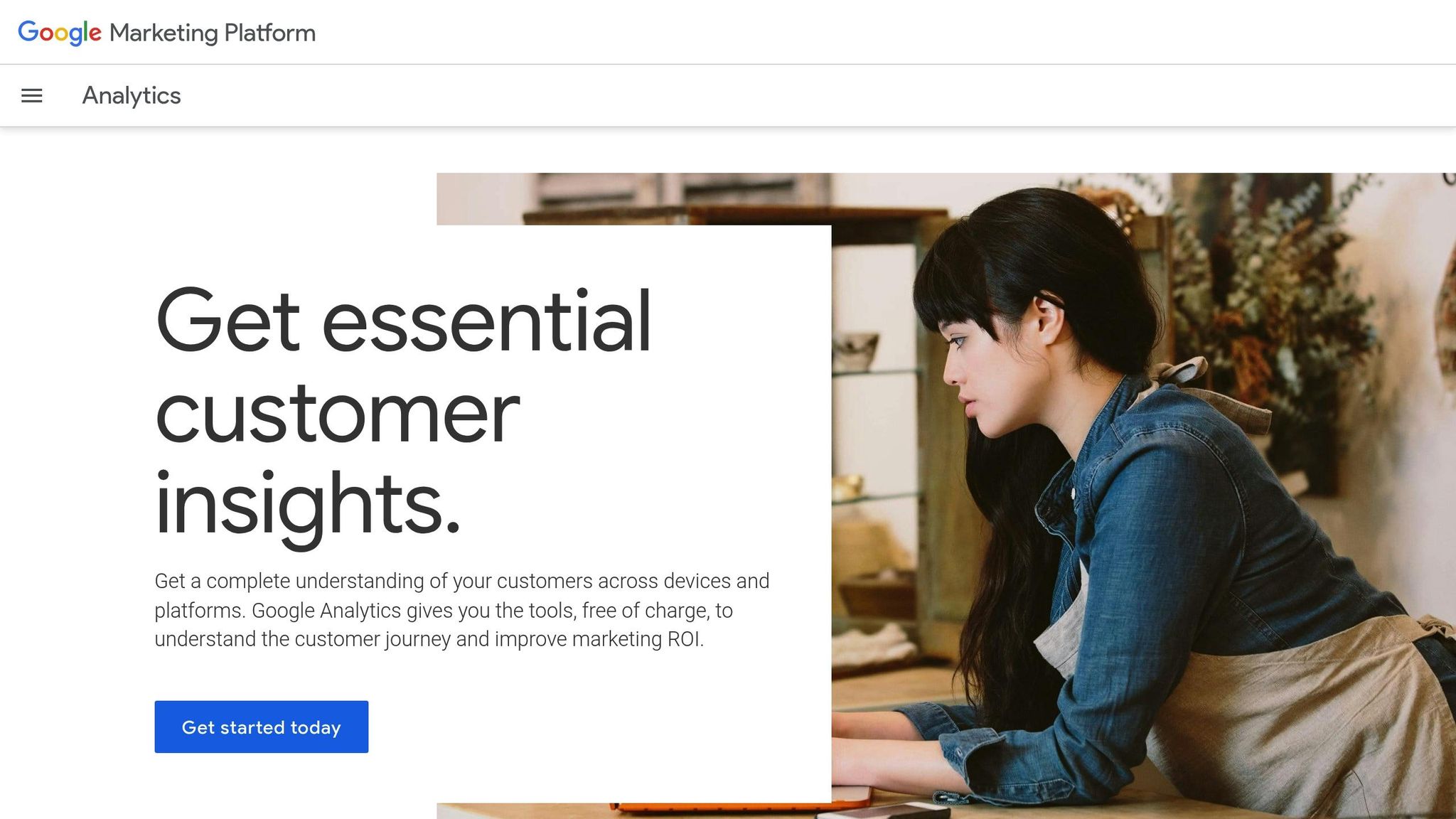
Google Analytics 4 (GA4) stands out as a must-have tool for startups, offering free tracking for both websites and apps. What sets GA4 apart is its event-based data model, which replaces the traditional session-based approach. This gives startups a more adaptable way to analyze user behavior and track interactions across multiple digital platforms. By combining data from websites and apps, GA4 provides a complete view of the customer journey, making it invaluable for startups with diverse online touchpoints.
One of GA4’s strongest features is its privacy-focused design. It anonymizes user IPs automatically and integrates consent management tools, which is a big plus for startups working to comply with regulations like GDPR and CCPA. It also allows startups to delete user data upon request and control how long data is retained.
Key Features and Functionality
GA4 leverages Google’s machine learning to deliver predictive insights without the need for complex models. It continuously monitors data for unusual patterns, helping startups stay ahead of the curve. Its event-driven model supports custom events and parameters, giving businesses more control over data collection. Enhanced Measurement, introduced in 2025, simplifies tracking for metrics like scroll depth, file downloads, and video engagement.
Another standout feature is GA4’s ability to analyze cross-platform user behavior. This helps startups understand how users move between their website and mobile app. Its advanced audience-building tools enable businesses to identify valuable user segments based on behavioral patterns. For deeper insights, GA4 offers Explorations – a suite of analysis tools that go beyond standard reporting. Integration with Google Ads also provides a clearer picture of marketing performance.
Free Plan Limitations and Scope
While GA4 offers robust features, its free version has some constraints. User-level and event-level data retention is capped at 14 months, with a default of 2 months unless manually adjusted. Aggregated reports remain accessible even after raw data is deleted. The free plan also limits startups to 25 event parameters per event and 25 user properties per property, with custom dimensions and metrics capped at 50 each – significantly less than the 125 available in GA360. Additionally, large datasets may be subject to data sampling, which can affect report accuracy for high-traffic sites.
BigQuery export is restricted to 1 million events per day, which might become a bottleneck as startups grow. The free version also lacks dedicated support, leaving startups to rely on community forums and documentation for troubleshooting. For websites with over 500,000 sessions per month, data processing and reporting delays can occur, making these limitations more noticeable.
Best Use Cases for Startups
GA4 is a powerful tool for startups looking to understand multi-channel customer journeys. It’s especially effective for businesses with both web and mobile platforms. Startups can use Enhanced Measurement as a starting point and then build on it with custom events to gain deeper insights into user behavior. This helps identify which content drives the most engagement and which features users interact with the most.
One of GA4’s standout capabilities is its predictive audience feature. Startups can create segments of users likely to churn or those with high purchase intent, enabling targeted re-engagement or upselling without manual analysis. For marketing campaigns, mastering UTM parameters is essential to track the performance of different channels. GA4’s conversion tracking ensures accurate attribution of user actions across the funnel. By setting up User-ID and configuring identity spaces, startups can achieve precise cross-device tracking, which is crucial for businesses with users interacting across multiple devices.
Scalability and Upgrade Triggers
For most startups, GA4’s free version is sufficient during early growth stages. However, as traffic grows – especially beyond 500,000 sessions per month – upgrading to GA360 becomes a practical step. Priced at $50,000 annually, GA360 is ideal for startups with substantial traffic and budgets. It offers extended data retention, advanced customization, and dedicated support with service level agreements.
Before committing to an upgrade, startups can maximize the free plan by linking GA4 to BigQuery. This prevents the loss of user-specific data after the 14-month retention period. Additionally, using Looker Studio for advanced data visualization and creating custom user properties can help startups extract more value from the free version. These strategies allow startups to make the most of GA4 during critical growth phases.
Tool Comparison Chart
In a world where startups juggle tight budgets and aim for rapid growth, picking the right tools can make all the difference. The right mix of free marketing tools can give your startup the boost it needs during those critical early stages. Below is a chart that breaks down the key features, free plan limits, and best use cases for popular tools, helping you zero in on the ones that match your current needs.
| Tool | Free Plan Limits | Key Features | Best Use Cases |
|---|---|---|---|
| Canva | Limited access to design assets | Drag-and-drop editor, a variety of templates, basic brand kit | Creating social media graphics, presentations, and other visual content for non-designers |
| Mailchimp | Up to 500 contacts, 1,000 sends/month | Email templates, landing page builder, basic automation, audience segmentation | Running email campaigns and nurturing leads for startups in their early stages |
| Apollo.io | Basic free plan | Contact database, email sequences, CRM integration | Generating B2B leads, sales prospecting, and outbound campaigns |
| Loops.so | Basic free plan | Transactional emails, behavioral triggers, API integration | Driving product-led growth, onboarding users, and managing SaaS notifications |
| Tally.so | Free plan available | Conditional logic, payment integration, custom branding | Collecting leads, gathering feedback, and running product validation surveys |
| Dub.co | Free plan available | Custom domains, QR codes, link tracking | Managing social media marketing, tracking campaigns, and creating branded short links |
| Mixpanel | Generous free tier | Event tracking, funnel analysis, cohort reports | Analyzing user behavior, optimizing conversions, and tracking product analytics |
| Senja.io | Free plan available | Review collection, social proof widgets, testimonial management | Running social proof campaigns, boosting website conversions, and managing customer testimonials |
| Ahrefs Free SEO Toolkit | Up to 150 keyword ideas | Keyword research, difficulty checker, rank tracking | Planning SEO strategies, researching content ideas, and analyzing competitor keywords |
| Google Analytics 4 | Standard free analytics features | Cross-platform tracking, predictive insights, custom events | Tracking website performance, mapping user journeys, and multi-channel attribution |
This chart offers a snapshot of what each tool brings to the table. For example, Mailchimp’s free plan is capped at 500 contacts, but it also includes features like customer journey mapping. Meanwhile, Ahrefs focuses on keyword research and SEO planning, giving startups a solid foundation for content strategies.
As your startup grows, you’ll need to keep an eye on when free plans might no longer meet your needs. Planning ahead for upgrades ensures smooth transitions without interrupting your marketing operations. For instance, tools like Mixpanel and Apollo.io offer robust free plans, but scaling businesses may eventually require premium features.
Another takeaway: combining tools can maximize efficiency. Pairing Canva with Mailchimp, or using Ahrefs alongside Google Analytics, can build a cost-effective and powerful marketing stack. Integration between tools is key here. When tools share data smoothly, your workflows stay lean and efficient – an absolute must for startups aiming to scale smartly.
Conclusion
Looking at the strengths of each free tool, it’s evident that a stage-based strategy is key to achieving success. Free marketing tools offer lean teams the chance to compete with larger players without hefty investments. From automating emails to gaining deep insights through analytics, these tools give startups the ability to test ideas, refine strategies, and grow efficiently.
The tools you choose should align with your startup’s current phase. During the MVP (Minimum Viable Product) stage, prioritize validation and feedback. For instance, tools like Tally.so can help you gather survey data, while Google Analytics 4 provides insights into user behavior. Pair these with Canva to create simple, visually appealing landing page designs. This streamlined approach keeps things manageable while helping you assess market demand quickly.
As your startup grows, your toolkit should evolve too. Beyond the MVP phase, consider combining Mailchimp for email automation with Mixpanel for tracking user behavior to inform your strategies. For B2B outreach, Apollo.io is a great option, while Ahrefs can bolster your content strategy through keyword research. By integrating these tools, you can stay efficient without adding extra costs.
Of course, there’s a point where upgrading becomes necessary. When free plan limits start to hold you back or advanced features become essential, it’s time to invest. Data shows that businesses leveraging freemium models see 50% lower customer acquisition costs and 15% higher net revenue retention.
Start by addressing your most pressing challenges, then expand your toolkit gradually. Conduct quarterly reviews to identify which tools are delivering results and which aren’t pulling their weight. Free tools can drive your strategy, but success depends on thoughtful planning and consistent follow-through.
Interestingly, the freemium model has shifted significantly, with a 500% rise in willingness to pay for premium tiers in recent years. Make the most of free options first, and when the time is right, upgrade strategically to support your growth as revenue allows.
FAQs
What are the advantages of using free marketing tools for startups instead of paid ones?
Using free marketing tools can be a game-changer for startups working with limited budgets. These tools allow businesses to manage essential tasks like social media, email campaigns, SEO, and content creation – without draining their finances. This flexibility lets startups try out different strategies and figure out what works, all while keeping costs low.
What’s even better is that many of these free tools are packed with features designed specifically for small businesses, making them an effective way to grow. They offer a risk-free opportunity to expand marketing efforts and test new ideas. Plus, working with free tools often sparks creativity, pushing startups to find clever ways to meet their goals without spending big. And when the time comes, upgrading to paid versions can unlock even more advanced features.
When should a startup upgrade from a free marketing tool to a paid plan?
Startups often reach a point where sticking with free marketing tools just doesn’t cut it anymore. If you’ve hit limits – like caps on email sends, the number of stored contacts, or restricted analytics – it’s probably time to think about upgrading. These limitations can hold back your growth and make your processes less efficient.
Another sign? When your team starts needing more advanced features, such as detailed reporting, automation, or access to dedicated customer support, a paid plan can become essential. Plus, if free tools are causing delays, downtime, or other performance hiccups that slow productivity, investing in a paid option can help streamline your efforts and keep things running smoothly. Focus on choosing tools that match your current growth stage and deliver clear value for the money you spend.
What are some effective combinations of free marketing tools that startups can use to boost efficiency?
Pairing the right free tools can simplify marketing for startups while keeping things efficient. Take Mailchimp and Canva, for instance – Mailchimp handles email marketing, while Canva makes designing polished newsletters and promotional materials a breeze. Together, they let you create stunning campaigns without needing a big budget or a design team.
Another great pairing? Google Analytics and Buffer. Google Analytics helps you understand where your traffic comes from and how your audience behaves, while Buffer streamlines social media management. Combine them, and you can fine-tune your social media strategy with data-driven insights.
For team collaboration, Trello and Slack are a winning combo. Trello organizes projects and tasks visually, while Slack keeps communication flowing smoothly. Together, they help startup teams stay on top of campaigns and meet deadlines without missing a beat. These tool combinations not only save time but also boost productivity – perfect for startups looking to do more with less.
Related Blog Posts
- Marketing Tech Stack Checklist for Early-Stage Startups
- 5 Ways AI Can Optimize Marketing ROI for your Tech Startup
- 10 Best Marketing Tools for Startups in 2025
- Checklist for Choosing AI Marketing Budget Tools




